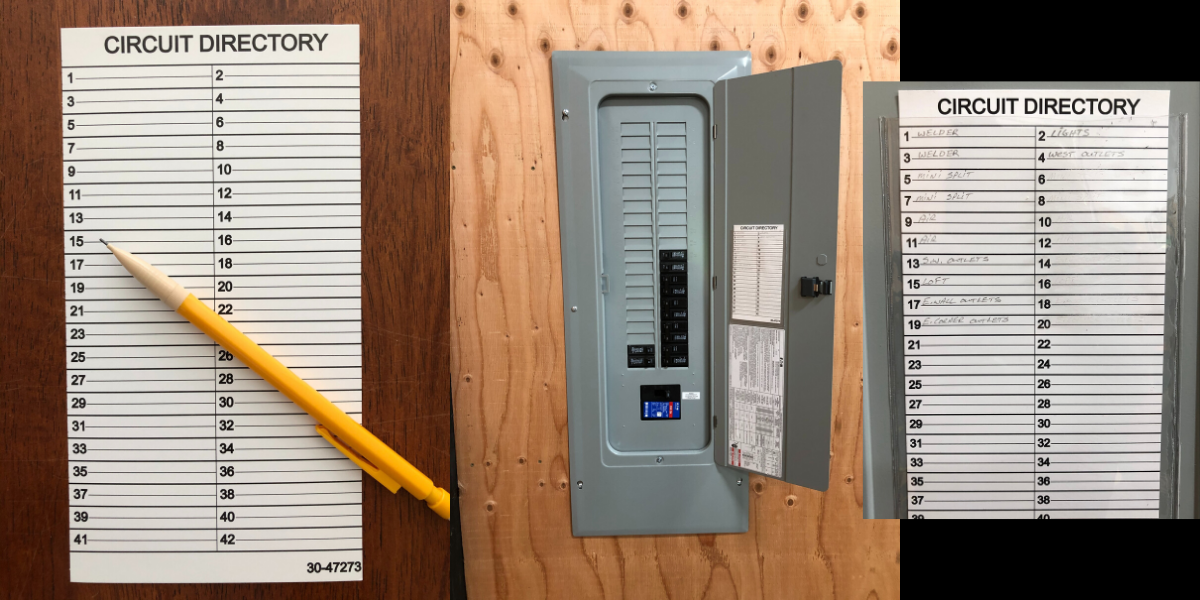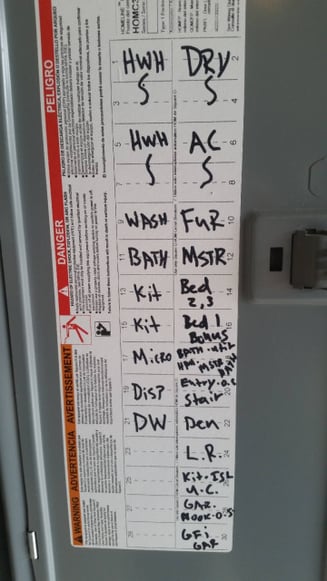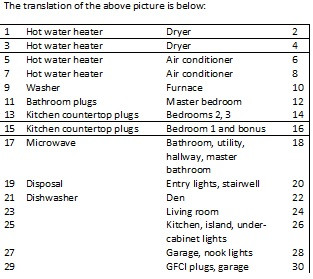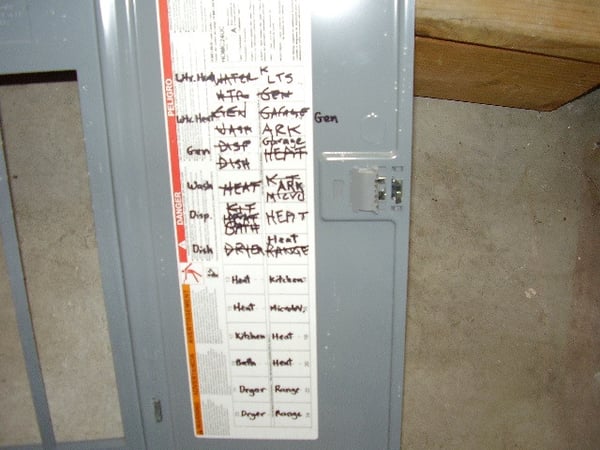
Nothing can be more frustrating than when you need to turn a circuit off in your house and you find that you don't know which one it is. Here is some information to explain how it should be done.
The Rules
2020 National Electrical Code (NEC) Article 110.12 states: "Electrical equipment shall be installed in a neat and workmanlike manner."
2020 NEC Article 408.4(A) states: "Every circuit and circuit modification shall be legibly identified as to its clear, evident, and specific purpose or use. The identification shall include an approved degree of detail that allows each circuit to be distinguished from all others. Spare positions that contain unused overcurrent devices or switches shall be described accordingly. The identification shall be included in a circuit directory that is located on the face, inside of, or in an approved location adjacent to the panel door in the case of a panelboard and at each switch or circuit breaker in a switchboard or switchgear. No circuit shall be described in a manner that depends on transient conditions of occupancy."
The code also specifically states that "[n]o circuit shall be described in a manner that depends on transient conditions of occupancy." That means that you cannot use terms specific to your house to describe the circuits. For example, you cannot describe a bedroom as Tim's bedroom since Tim will not always occupy that room and future homeowners won't know which room that is describing.
Example of a panel labeled the wrong way

Here is a great example of an electrical panel schedule that has not been labeled correctly, it does not meet the code requirements described above. It was not done in a neat and workmanlike manner and every circuit is not legibly identified as to its clear, evident, and specific purpose or use. You cannot use abbreviations to describe what is on each circuit and you cannot use the same description on multiple lines. For example, lines 13 and 15 both say "Kit" which stands for kitchen. In order to label this correctly, each circuit needs to be more specifically identified (west kitchen plugs; east kitchen plugs; etc.). Also, lines 20 and 28 use a symbol to describe lights in the entry and nook rather than writing out the word lights.
Of course, you don't need to write a novel when filling in the blanks, but they need to be descriptive enough to understand exactly what the circuit is for. And each line that is used must be filled in and none of them can use the exact same description. For example, in this picture, lines 1, 3, 5, and 7 all say hot water heater. Those need to be more specifically identified (hot water heater front/right; hot water heater rear/left; etc.).
As to the rule about "transient conditions of occupancy," this panel describe bedrooms 1, 2, and 3 on lines 14 and 16. No one going to that house later knows which bedrooms those descriptions are for. In a case like this, it is best to label them more specifically, such as southwest bedroom; upstairs north bedroom; basement west bedroom; etc.
Here is the translation of what this panel schedule is trying to show:

How to label a panel the right way
As explained above, your electrical panel schedule/circuit directory needs to be labeled neatly and within certain rules about the description of each line. Follow these steps to make sure your panel is labeled correctly:
- Each circuit needs to be specifically identified.
- Do not use abbreviations or symbols to describe what is on each circuit.
- Fill in each line that is used.
- Do not use the exact same description for more than one circuit.
- Do not use terms specific to your house to describe the circuits. It is best to label them specifically, such as southwest bedroom; upstairs north bedroom; basement west bedroom; etc. instead of bedrooms 1, 2, and 3.
Below is another example of an electrical panel schedule that was not labeled correctly.
Circuit Directory
One of the exciting changes to the National Electrical Code (NEC) for 2020 was the addition of the bolded language, "The identification shall be included in a circuit directory that is located on the face, inside of, or in an approved location adjacent to the panel door in the case of a panelboard and at each switch or circuit breaker in a switchboard or switchgear."
In the past, we had to use the small circuit directories included with the electrical panel to identify all the circuits in a home. As you can imagine, houses have become much more complex with many more circuits that need to be identified and it can be hard to do it right on those small directories.
This new language allows homeowners and electricians to install the circuit directory adjacent to the electrical panel, which means we can use larger directories. This makes it much easier to include more detail on the directory to correctly identify all the circuits being used in a house. If you don't want to use the directory included with your electrical panel, you can purchase blank directories like this one from stores like Home Depot.
When Classic Electric completes a service change or electrical panel change, we always make sure the panel schedule/circuit directory is completed in accordance with the current NEC rules.
Are you considering a residential remodel project, an electrical panel change or upgrade, or a garage or shop electrical project? Thomas Adams is an Oregon Master Electrician, with an Inspector Certification, who has over 25 years of experience in the industry and he would be happy to talk to you about your Tigard electrician needs.




